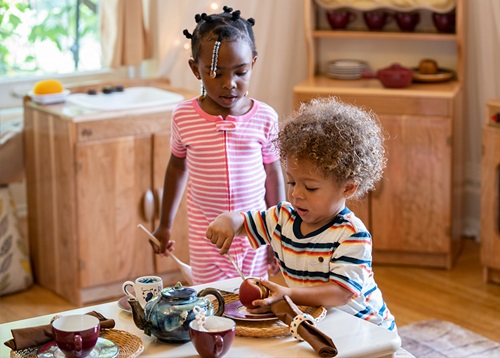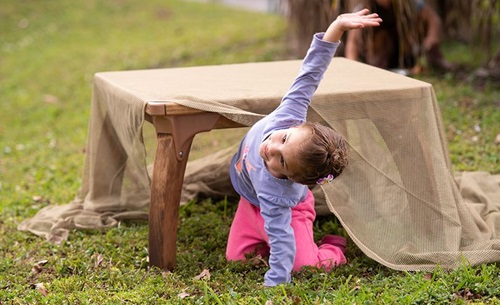Making Language Come Alive
Learning Literacy through Storytelling/Story Acting
|
September 2014
LEARNING TO READ—that academic skill that is considered necessary to school and life success, looms heavily for children, even in preschool. But how do children develop strong literacy skills and what can early childhood teachers do to support them in a sensible, developmentally appropriate manner? For too many children, learning to read has become a daunting, high stakes chore to be mastered in order to score well on standardized tests.
Teaching reading controversies have raged for more than 50 years starting with the publication in 1955 of Why Johnny Can’t Read. Since then there have been enough books, articles, and research papers about the subject to circle the globe. But perhaps “Johnny can’t read” because the joy, excitement, and relevance of reading has been removed from the young child’s introduction to language and literacy.
Most people who have worked with young children agree that each child learns to read in a different way, at a different rate or time, and that a combination of approaches helps. We also know that culture, experience, and confidence contribute to how and when children learn to read. There is no single approach or curriculum that will help all children learn to read and no magic age for all children to have mastered reading.
Most educators, however, will agree that the following conditions contribute to a young child’s development of literacy skills:
- A home life full of conversation and oral stories.
- Being read to from an early age.
- Rich, meaningful, real-life language experiences.
- Learning experiences that are stress-free and pleasurable.
- And, of course, a good deal of play.
Therefore, it only makes good sense to provide young children with language experiences that promote a love of books, language, and story within a play-based environment filled with rich conversation and meaning. Vivian Gussin Paley, teacher, writer, and play advocate, developed a technique of combining storytelling and acting into the classroom routine in a fun and practical way.
Paley’s method of “Storytelling/Story Acting” is a simple way to engage young children in daily doses of rich language experience. The teacher sits with a child and encourages him to tell his own story in whatever shape or form he chooses. Listening and writing down the child’s spoken words, the teacher and child engage in relaxed conversation with an occasional question, “So you said the princess goes into the castle—do you mean the first princess or the second one?” The teacher reads back the child’s story during the telling, to check in and to clarify what the child wants to say. During this dictation period, the teacher sends a clear message that the child’s words and thoughts are valued and that she is truly interested in the child’s ideas. Because this story will be acted out later in a collaboration with the entire class, the teacher asks the child which character in the story he would like to be during the acting out.
When the teacher has collected a few stories, the children gather in a circle and the acting can begin! The teacher takes one story at a time and begins by asking each child if they wish to be a particular character in a particular story (“Would you like to be the tree?”). The storyteller has already made her choice so she is in the middle of the circle, waiting for the rest of the cast to assemble. Next the teacher narrates the story and as she reads, the children act it out.
At first glance, the stories may seem frivolous and the acting silly. But watch carefully. Listen intently. Read back those stories over time and remember the faces of the children while they were acting. There is nothing frivolous or silly about what is taking place. And, over time, the children become more comfortable and capable.
Below are a few observations that several teachers and I have made about children engaged in Storytelling/Story Acting:
- The children understand each other’s stories even if the adult does not.
- The acting out makes the stories more real to the children.
- Children, who never participate in anything else in the classroom, are eager to participate in Storytelling/Story Acting.
- Children, for whom English is a second language, learn the language more readily because they are moving their bodies as the words are read.
- Children, who have difficulty because of behavior, Autism, shyness, or whatever else, will often choose this one activity over all others.
- That child who has difficulty in the classroom, who may not participate in other activities, is now noticed and acknowledged by her classmates. She is part of the group, the classroom community of people who care about each other.
- Children who avoid dictating stories or engaging in literacy activities want to tell a story, simply because they know they will get to act it out later.
- Then there are children who dictate stories but choose only to watch theirs and their friends’ stories acted out without participating in the acting themselves. Those children benefit by seeing the stories and ideas come to life. As members of the audience, they are contributing and participating in the process.
In my many years of visiting classrooms and as a classroom teacher, I have seen no activity that surpasses Storytelling/Story Acting for its powerful impact on children. The process brings the children together in ways that other activities cannot. The children communicate with each other by sharing their imaginative tales that incorporate fear, humor, high drama and, most importantly, the young child’s perception of the world. Children see their friends creating the characters before their eyes and that helps them to better understand their own thinking. They learn to be a good audience. They learn self-regulation through the acting process. For example, part of the story may call for a character to kick another character. The children are very good at being able to pretend kick without touching another child. Pretending comes naturally.
And there is no better endorsement than what the children themselves tell you. After spending time doing Storytelling/Story Acting with a second grade class, one child thanked me and said, “I didn’t know I had such big ideas to write about!”
From a language development and literacy standpoint, there is much taking place and plenty learned. Children look at the words on the page as the teacher writes them down. They want to know the words because those words belong to them. They hear the words of their story spoken, at least twice, and begin to develop a sense of narrative and how language is used in a variety of ways. Children will occasionally take a pencil and write words along with the teacher in her notebook. Language comes alive as they watch their friends act out stories. The whole process is both playful and serious at the same time.
And what does the teacher learn? The teacher learns about the way children think and how they interpret the world. She gets a good sense about the individual child’s language growth (a true understanding, not a test score) and is able to then be a better teacher. If she is open, thoughtful, and curious, she will learn astonishing things. She will eagerly share the children’s stories with colleagues and parents. Parent conferences become more meaningful and parents more appreciative of the teacher’s knowledge of their child and keen interest in him or her as a “whole” person.
And parents? I know of teachers that have involved parents in a variety of skillful ways. In one school, the teachers invited parents to dictate a childhood memory of their own and then the children acted out the parent’s memory. In some cases parents create Storytelling/Story Acting routines at home. Time and again, a parent with a special needs child relates how that child can participate freely with her siblings for the first time when telling and acting out stories with them. Other parents create Storytelling/Story Acting sessions at big family gatherings. Grandparents, uncles, nieces, and family members of all ages get involved.
It has been said that human beings are born to tell and listen to stories. We know that when information is shared in story-form, it’s remembered. We also know how important oral language is to development and that we all learn better when there is context, meaning, and an emotional connection to whatever is presented. There is abundant evidence that movement adds to deeper learning, especially for young children. Storytelling/Story Acting satisfies all of these criteria and more. It respects the child, advances community, and builds a child’s self worth.
I urge teachers to include Storytelling/Story Acting in the daily life of their classroom. Read Vivian Paley’s books, savor her words, and think about what is important for the children with whom you work. Share Paley’s books with your colleagues and create your own Storytelling/Story Acting study group. You won’t be disappointed.
If you would like more information or advice, contact me at Judipack@yahoo.com







